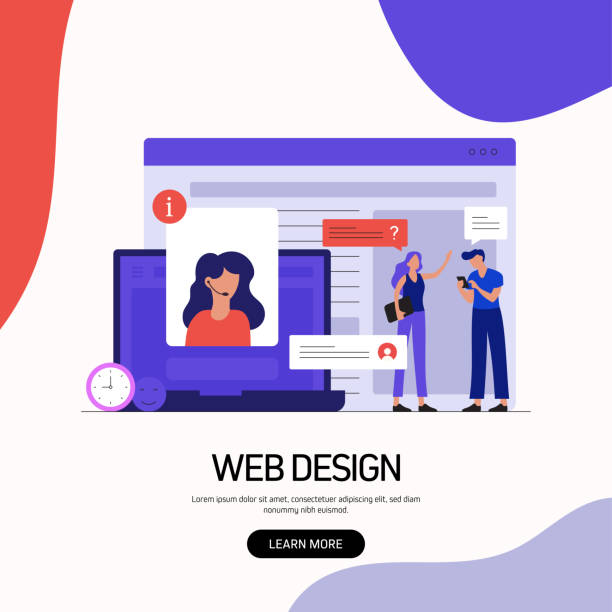Introduction to Responsive Website Design and its Importance

In today’s digital world, where users access websites through a variety of devices such as mobile phones, tablets, laptops, and even smartwatches, the importance of responsive website design has become more evident than ever.
#Responsive_Design is not just a design trend, but a strategic necessity for any business seeking to survive and thrive in the online space.
This web design approach ensures that your website intelligently reacts to the user’s screen size, providing an optimal visual and user experience.
This means there is no longer a need to develop multiple separate versions of the website for different devices; instead, a single, flexible code handles compatibility with any size.
This significantly reduces maintenance and development burden while increasing the website’s compatibility and accessibility for a wide range of users.
From a #User_Experience perspective, a responsive website allows users to easily view and interact with content without needing to zoom in or scroll horizontally.
This feature directly impacts user satisfaction and, consequently, increases conversion rates.
Also, from an #SEO standpoint, Google officially recommends responsive design as the best practice for mobile-friendly websites, which greatly helps improve website rankings in search results.
This section provides a comprehensive explanatory overview of the foundations of this technology and the necessity of adopting it in the current era, to foster a deeper understanding of its potential and pave the way for more specialized educational discussions in subsequent chapters.
Did you know that 94% of users’ first impressions of a business are related to its website design? With professional corporate website design by **Rasawweb**, turn this first impression into an opportunity for growth.
✅ Attract more customers and increase sales
✅ Build credibility and trust in the eyes of the audience⚡ Get free website design consultation!
Why is Web Responsiveness a Requirement? Analyzing Today’s Needs

In the current era, where smartphones and tablets have become the primary tools for internet access, responsive website design is no longer a luxury option, but a vital necessity.
Statistics show that a significant portion of web traffic comes from mobile devices, and this trend continues to grow.
A website that does not display correctly on small screens not only leads to a poor user experience but can also result in losing customers and diminishing brand credibility.
Search engines like Google also prioritize websites with responsive design due to the importance of mobile experience.
This has gained double importance, especially with Google’s introduction of “Mobile-First Indexing”; meaning that the mobile version of your website is used for ranking in search results.
The absence of responsive design can directly negatively impact your site’s SEO and reduce its visibility to the target audience.
From an analytical perspective, this paradigm shift in content consumption has forced businesses to change their approach to web development.
A fixed website optimized only for desktops will be inefficient when faced with a wide range of devices and screen sizes.
This chapter provides an informative and analytical look at current data and future trends in the digital market, emphasizing why investing in this area is an investment in the future of your business.
Providing a seamless and hassle-free experience for the user, regardless of the device they use, is key to success in this competitive ecosystem, and this is exactly what responsive design offers.
Fundamental Principles and Techniques in Responsive Design

For successful implementation of responsive website design, understanding its fundamental principles and techniques is essential.
This approach is based on three main pillars: Flexible Grids, Fluid Images, and Media Queries.
Flexible grids mean that the website layout uses relative units like percentages instead of fixed pixel units.
This allows page elements to dynamically scale with screen size changes and fill the available space optimally.
Fluid images also use CSS to adjust the image width so that it never exceeds its container’s width, preventing horizontal scrolling.
This is a technical and very important aspect, as large images can slow down site loading and disrupt the user experience.
But perhaps the most important element in responsive design is Media Queries.
This CSS3 feature allows developers to apply different styles based on device characteristics such as screen width, height, orientation (portrait or landscape), and even resolution.
For example, you can display a navigation bar horizontally on large screens and transform it into a hamburger menu on small screens.
These educational techniques form the backbone of any responsive website, and mastering them is essential for any developer intending to create a modern and compatible website.
Understanding these fundamentals allows you to build complex and beautiful layouts that look great on any device.
| Feature | Responsive Design | Adaptive Design |
|---|---|---|
| Mechanism | A fluid layout using Media Queries that adjusts itself to any screen size. | Several pre-defined fixed layouts for specific screen sizes. |
| Number of Layouts | A single layout for all devices. | Multiple layouts based on specific Breakpoints. |
| Flexibility | Highly flexible and dynamic for any screen size. | Less flexible, limited to defined breakpoints. |
| Development Complexity | Usually has higher initial complexity, but is easier to maintain. | May seem simpler at first, but maintaining multiple layouts can be more complex. |
| Performance | Can have good performance with proper resource management (e.g., images). | Can have better performance by loading precise resources for each device. |
The Impact of Responsive Design on User Experience and Interface (UX/UI)

Responsive website design plays a central role in improving User Experience (UX) and User Interface (UI).
A well-designed responsive website provides a seamless and pleasant visual experience, regardless of the user’s device screen size.
This means that texts are easily readable, images are correctly scaled, and interactive elements such as buttons and forms are easy to use, without the need for zooming or unintended scrolling.
User experience (UX) improvements directly impact the user’s time spent on the site, the number of pages visited, and ultimately, the conversion rate.
If users can easily find what they are looking for and interact with the content without issues, their likelihood of returning to the site and performing the desired action (such as purchasing or signing up) significantly increases.
From an explanatory perspective, responsiveness means optimizing navigation; for example, large desktop menus transform into compact hamburger menus on mobile to efficiently use screen space.
This approach also contributes to accessibility, as the site’s content and functionality become more accessible to individuals with different abilities and various devices.
Providing a beautiful and efficient User Interface (UI) across all devices not only helps strengthen the brand but also demonstrates professionalism and attention to detail.
This section offers comprehensive guidance for understanding this interaction between responsive design and user experience quality, showing how these two concepts together can contribute to a website’s success.
Are you bothered by losing customers who visited your site to make a purchase?
Rasawweb is your specialized solution for having a successful online store.
✅ Significant increase in your online sales
✅ Building trust and professional branding with customers⚡ Get free consultation from Rasawweb specialists!
SEO Benefits of Responsive Website Design

One of the most important reasons businesses have moved towards responsive website design is its countless benefits for Search Engine Optimization (SEO).
Google, as the largest and most widely used search engine, has clearly stated that it prefers responsive websites over separate mobile and desktop websites.
The main reason for this preference is the ease of crawling and indexing content.
By having a single URL and integrated content that automatically adjusts to screen size, Google bots do not need to crawl two separate versions of the site, which consumes fewer resources and makes the indexing process faster and more efficient.
This directly helps improve site rankings in search results.
Furthermore, responsive design helps reduce the Bounce Rate.
When users access a website from mobile devices that offers a poor user experience (due to lack of responsiveness), they quickly leave the site.
This high bounce rate signals to Google that your site is not suitable for mobile users and can lead to a lower ranking.
In contrast, a responsive website provides a positive experience that encourages users to stay and explore further.
This detailed analytical overview of the close relationship between responsive design and SEO shows how a smart investment in web design can lead to a significant improvement in online visibility and attract more organic traffic.
A mobile-optimized website literally provides a strong foundation for your SEO strategy.
This is a key guidance for any business looking to increase its online presence.
Tools and Frameworks for Responsive Design Development

Developing responsive website design is now much more organized with the use of numerous tools and frameworks that make the work easier for developers.
These tools help make the design and implementation process faster, more efficient, and with fewer errors.
One of the most popular and well-known frameworks is Bootstrap.
Bootstrap is a CSS, HTML, and JavaScript framework that provides an extensive set of pre-defined UI components and a powerful Grid System for responsive design.
This framework enables developers to quickly build responsive websites without needing to write complex CSS codes from scratch.
Another popular framework is Foundation, which, like Bootstrap, offers a set of necessary tools for building responsive websites and focuses more on flexibility and customization.
In addition to frameworks, core CSS technologies such as CSS Grid and Flexbox also play a key role in responsive design.
CSS Grid is highly efficient for more complex two-dimensional layouts, and Flexbox for distributing and aligning elements in one dimension (row or column).
These tools and frameworks facilitate the technical knowledge required for modern web design and help developers find educational and practical solutions for responsive design challenges.
The choice of the right tool depends on the project’s complexity, specific needs, and the development team’s preferences.
Common Challenges and Problems in Responsive Website Design

Despite its many advantages, implementing responsive website design can also come with challenges that require attention and appropriate solutions.
One of the most important challenges is performance management.
Sometimes, to be compatible with different devices, high-resolution images and resources may be loaded for all devices, which can severely reduce website loading speed, especially on mobile devices with slower internet.
This is a challenging aspect of how to maintain a balance between visual aesthetics and speed.
Another challenge is the complexity of managing Media Queries, especially in large projects with many breakpoints.
This can lead to messy and difficult-to-maintain CSS codes.
Also, testing and debugging the website across a wide range of devices and browsers can be time-consuming and complex.
Ensuring that the website displays correctly at every size and in every environment requires comprehensive testing tools and precise processes.
There are also issues related to device-specific user experience; for example, interaction with a mouse and keyboard on a desktop is different from touch interaction on mobile, and these differences must be considered in the design.
This technical section aims to clarify these challenges and provide a deeper understanding of the obstacles you might face when implementing responsive web design.
Identifying these problems is the first step in finding effective solutions and optimizing the design process.
| Challenge | Description | Solution |
|---|---|---|
| Slow Performance | Loading high-resolution images for all devices, excessive CSS and JS codes. | Using Lazy Loading for images, image optimization (compression, web-friendly formats), code compression. |
| Media Queries Complexity | Too many breakpoints, difficult code management, and potential inconsistencies. | Using a Mobile-First approach, grouping Media Queries, using CSS preprocessors (like Sass). |
| Navigation Issues | Complex menus on small devices, difficulty accessing links. | Designing hamburger or accordion menus, using large and tappable buttons, thorough navigation testing. |
| Testing and Debugging | Need to test on a wide range of devices and browsers. | Using browser emulators, testing on real devices, cloud testing platforms. |
| Excessive Content | Displaying all desktop content on mobile, which can lead to clutter and confusion. | Prioritizing content for different devices, hiding or altering the display of less important elements on mobile. |
Testing and Debugging Responsive Websites

After implementing responsive website design, the next crucial step is testing and debugging to ensure that the website functions correctly across all devices and browsers.
This step is as important as the design itself, as even the smallest inconsistency can disrupt the user experience.
For testing, you should first use browser’s built-in tools like “Developer Tools”.
Almost all modern browsers (such as Chrome, Firefox, Edge) have the ability to simulate different screen sizes and even mobile devices.
These tools allow for quick changes in screen width and height, network speed simulation, and even touch testing, serving as excellent guidance for initial testing.
However, simulators cannot completely reproduce the actual behavior of devices.
Therefore, testing on real devices is essential.
This includes testing the website on various smartphones and tablets with different operating systems (iOS, Android) and various browsers.
This technical approach ensures that all details related to touch interaction, image loading, and overall performance are checked in a real environment.
Also, cloud testing platforms like BrowserStack or CrossBrowserTesting allow for simultaneous testing on hundreds of browser and device combinations, which is very useful for large projects.
This educational phase not only identifies bugs but also helps further optimize the code and content for better performance across different devices.
Continuous debugging and attention to detail in this stage are crucial for the final success of a responsive website.
Tired of your e-commerce website not generating as much revenue as it could? Rasawweb, specializing in professional e-commerce website design, solves this problem for good!
✅ Increase sales rate and revenue
✅ High loading speed and unparalleled user experience
⚡ Get free e-commerce website design consultation
Future Trends in Responsive Website Design

The web world is constantly evolving, and responsive website design is no exception.
New trends are emerging that are shaping the future of this field, moving towards smarter and more dynamic designs.
One of the most important trends is the growth of Progressive Web Apps (PWAs).
PWAs are websites that offer native app capabilities such as offline functionality, push notifications, and installation to the home screen.
This technology significantly improves the mobile user experience and goes beyond mere responsiveness.
Another trend is the increased use of Artificial Intelligence (AI) and Machine Learning in the design process.
AI-powered tools can help optimize layouts, personalize content based on user devices, and even predict future design needs.
This is an exciting development for developers.
Also, the increased use of Container Queries instead of Media Queries allows for more control over the layout of internal elements of a component, without being dependent on the entire page size.
This analytical approach makes design more modular and manageable.
The emergence of wearable devices and virtual/augmented reality also brings new challenges for responsive web design, requiring novel approaches to UI design.
These trends indicate that the future of web design is not only about adapting to different screen sizes but also about providing intelligent and personalized user experiences across every digital platform.
This is a fascinating yet serious discussion about the future that lies ahead.
Conclusion and Best Practices for Implementing Responsive Design

In summary, responsive website design is no longer a competitive advantage but an industry standard and a prerequisite for success in today’s online space.
From improving user experience and increasing accessibility to critical SEO benefits and reduced maintenance costs, its advantages are countless.
For successful implementation of responsive design, adhering to best practices is essential.
First and foremost, adopt the “Mobile-First” approach.
This means starting design and development for the smallest screens first, and then gradually expanding it for larger screens.
This approach not only simplifies the design process but also ensures that the most important content and functionalities are prioritized.
Second, do not forget performance optimization.
Using optimized images, Lazy Loading, and code compression are actions that can improve site loading speed on all devices.
Third, conduct comprehensive and continuous testing.
As previously mentioned, testing on real devices and using simulation tools are crucial to ensure correct functionality in all scenarios.
Fourth, pay attention to accessibility; a responsive site must be accessible to all users, including those with disabilities.
This includes using semantic code, appropriate color contrast, and keyboard navigation capability.
This explanatory section not only summarizes what has been discussed but also serves as practical guidance for anyone intending to build a future-proof website.
By adhering to these principles, you can ensure that your website remains at its peak performance and appeal, providing an unparalleled user experience for your audience, both today and in the years to come.
Frequently Asked Questions
| Question | Answer |
|---|---|
| What is responsive website design? | It is a web design approach that ensures websites are displayed and usable across various screen sizes (mobile, tablet, desktop). |
| Why is responsive design important? | Due to the increasing use of diverse devices with different screen sizes (such as mobile phones and tablets) by users to access websites. |
| What are the main technologies used in responsive design? | It uses techniques such as Media Queries in CSS, Flexible Grids, and Fluid Images. |
| What are the benefits of responsive design? | Providing a better user experience across all devices, improving website SEO, reducing maintenance costs (compared to having a separate mobile site). |
| Is responsive design necessary for all websites? | Mostly yes, as it ensures your site is accessible and functional for a wide range of users and the devices they use. |
And other advertising services of Rasawweb Advertising Agency
Smart Brand Identity: A professional solution for digital branding focusing on key page optimization.
Smart Content Strategy: A fast and efficient solution for digital branding focusing on intelligent data analysis.
Smart Link Building: A professional solution for increasing website traffic focusing on user experience customization.
Smart Advertising Campaign: A professional solution for digital branding focusing on intelligent data analysis.
Smart Marketing Automation: A dedicated service for growing customer acquisition based on marketing automation.
And over hundreds of other services in the field of internet advertising, advertising consultation, and organizational solutions
Internet Advertising | Advertising Strategy | Advertorial
Sources
What is Responsive Website Design?
Comprehensive Guide to Responsive Design
UI/UX Design Principles
Responsive Website Development
✅? To shine in the online space, you need a reliable partner. Rasawweb Afarin, a leading digital marketing agency, paves your path to digital success by providing comprehensive services including SEO, smart advertising, and personal website design. Contact us today and transform the future of your business!
📍 Tehran, Mirdamad Street, next to Bank Markazi, Southern Kazeroun Alley, Ramin Alley No. 6

